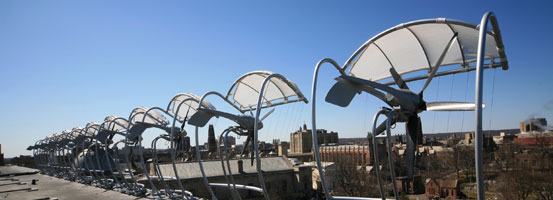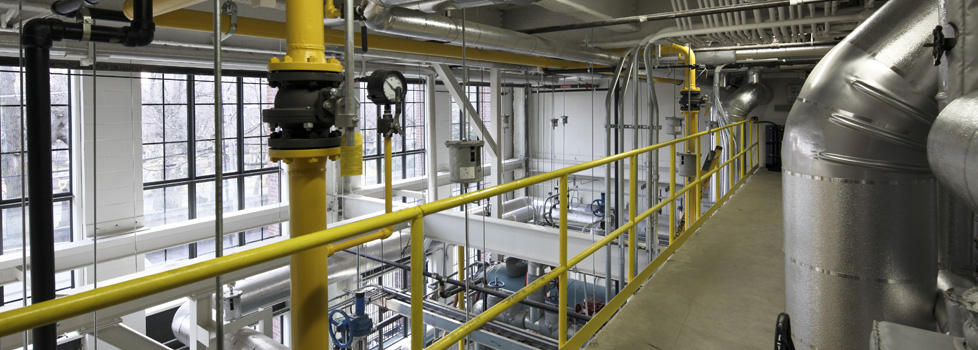Campus Utilities
Utilities services manages all aspects of the generation, distribution, and metering of energy for all university campuses. The University's utilities facilities include:
- Central Power Plant (CPP)
- Sterling Power Plant (SPP)
- West Campus Power Plant (WCPP)
- Central Campus Chiller Plant (CCCP)
These plants generate and/or distribute steam for heating, chilled water for air conditioning and electric power. These services are distributed to buildings through underground distribution systems. Also included in this group is the engineering support for the following areas:
- Energy management and conservation
- Technical services
- Specifications and guidelines
- Technical documentation and records
Energy Management at Yale
Thermal energy for most buildings in the central and science areas of Yale's campus is produced in the Central Power Plant. The Sterling Power Plant serves the medical campus area and Yale-New Haven Hospital. Steam and chilled water produced in the plants are distributed to the buildings in underground tunnels or in direct buried pipes. Electricity is either purchased from the utility company or generated in the central campus cogeneration plant and distributed for the central and science areas.
Optimum use of energy is controlled by direct digital control systems in individual buildings, and monitored by a central building utilities metering system. Energy conservation is an inherent part of the control and monitoring systems.
The following is a tabular representation of the University standard temperatures, relative humidity (RH), and central air handling unit operation policy.
Yale Standards for Space Heating and Cooling
| Space Type | Cooling Setpoints | Heating Setpoints | Relative Humidity | ||||
| Occupied °F | Unoccupied °F | Recess/Vacant °F | Occupied °F | Unoccupied °F | Recess/Vacant °F | % | |
| Residential Classroom Office Assembly | 75* | 80 | No cooling | 68* | 65 | 60 | 65 or less |
| Laboratory** | 75* | 80 | 80 | 68* | 65 | 60 | 60 or less |
| Athletics | 72 | 80 | No cooling | 68 | 65 | 60 | 65 or less |
| Clinical | 75* | 80 | 80 | 68* | 65 | 65 | 20–60 |
| Cultural Properties | 72 | 75 | 75 | 68 | 65 | 65 | 45–55 |
*These setpoints may be modified +/- 2°F by the user of a space. Systems are designed to allow spaces to be cooled as low as 73°F and heated as high as 70°F.
**Laboratories may also be provided stand-by setpoints for spaces that are not occupied during normal business hours.
Production and Distribution of Energy
Steam is produced in the power plant burning either natural gas or oil with maximum efficiency and minimum pollution. It is distributed underground to the buildings where it is used for either direct heating, for reheating of hot water for heating, and use in the showers, bathrooms, etc., or as process steam used in the kitchen, laboratories, etc. Steam releases its energy (in radiators, heat exchangers), and is returned to the power plant as the most efficient feed water for the boilers, since it retains its thermal energy (120–180°F), and is chemically treated.
The University's energy conservation effort is focused on optimum utilization of equipment for steam generation, optimum production of steam in the boilers as well as on maximum return of condensate to the power plants.
Chilled water is produced in the power plant with maximum efficiency using either electricity or steam. The production is optimized utilizing the available equipment in the most economical way to meet the actual load of the campus. The chilled water supplied to the buildings is 42°F in the summer and 44°F in the winter, and is at sufficient pressure and flow to meet the cooling demand of the buildings.
The University's energy conservation effort is focused on optimum utilization of equipment for chill water production, optimization of chill water supply temperature, optimization of the cooling tower operations, and optimization of chill water pressure.
Electrical energy for the central and science areas of the campus is generated in the Central Power Plant, which is a cogeneration plant. The local utility company services the medical campus area. The cogeneration plant generates normal power as well as backup power. Both are distributed to the individual buildings.
The University's energy conservation effort is focused on optimum utilization of generating equipment and minimization of energy purchases from the utility company.
Steam, chill water and electricity are distributed from the plants to the buildings. Each building is individually metered and billed for energy usage. The building users and occupants have access to the building utilities metering system's data online: pub-max.facilities.yale.edu/Maxweb.
Energy Initiative

The production and use of energy from fossil fuels impacts our climate and community, and has become increasingly expensive as resources become scarcer. As a result of these impacts, in 2005 Yale President, Richard Levin, committed the University to reduce its greenhouse gas emissions 43% below 2005 levels by 2020. Further, the Sustainability Plan 2025 climate action ambition commits Yale to carbon neutrality by 2050. To accomplish this ambitious goal, Yale has embarked upon an ambitious energy program improving the efficiency of its power plants, updating buildings, utilizing emerging technologies, searching for clean energy alternative sources as part of its energy use portfolio, and investigating the use of carbon offsets. To learn more about how Yale is progressing toward its goal click here.
Equally important are the patterns and habits of energy use by students, faculty, staff and administrators. The example we set, as individuals and as a community, is also important as the rest of the world tackles its own energy challenges.
Energy Management Tools |
|
|
|
|


